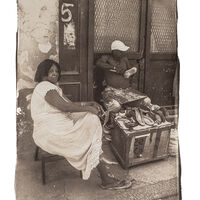VAN DYKE PRINTS
So named due to the similarity of the print colour to that of a brown oil paint named for Flemish painter Anthony van Dyke. This procedure was invented by Sir John Herschel in 1842 and utilises the action of UV light on a ferric and silver nitrate salt solution painted on the paper, and against which you place a negative the same size as the final print. Every print will be different; so many factors may influence/affect the end result, like the quality of the negative, the paper, the dosage of the chemicals, the time of UV exposure, the pH of the water, the fixing bath, etc.
Ce procédé est inventé par Sir John Herschel en 1842 et donne des tirages d'un brun similaire à celui utilisé par le peintre Anthony van Dyke, d'où le nom. Le papier est peint avec une solution de sels de fer et d'argent, et l'exposition se fait par contact direct avec le négatif soit avec une ensoleuse ou au soleil. Chaque tirage sera unique.
So named due to the similarity of the print colour to that of a brown oil paint named for Flemish painter Anthony van Dyke. This procedure was invented by Sir John Herschel in 1842 and utilises the action of UV light on a ferric and silver nitrate salt solution painted on the paper, and against which you place a negative the same size as the final print. Every print will be different; so many factors may influence/affect the end result, like the quality of the negative, the paper, the dosage of the chemicals, the time of UV exposure, the pH of the water, the fixing bath, etc.
Ce procédé est inventé par Sir John Herschel en 1842 et donne des tirages d'un brun similaire à celui utilisé par le peintre Anthony van Dyke, d'où le nom. Le papier est peint avec une solution de sels de fer et d'argent, et l'exposition se fait par contact direct avec le négatif soit avec une ensoleuse ou au soleil. Chaque tirage sera unique.
VANDYKE PRINT - CUBA STREETS 1

VANDYKE PRINT - CUBA STREETS 2

VANDYKE PRINT - CUBA STREETS 3

VANDYKE PRINT - CUBA STREETS 4

VANDYKE PRINT - CUBA STREETS 5

VANDYKE PRINT - CUBA STREETS 6

VANDYKE PRINT - CUBA STREETS 7

VANDYKE PRINT - CUBA STREETS 8

VANDYKE PRINT - CUBA STREETS 9

VANDYKE PRINT - CUBA STREETS 10

VANDYKE PRINT - CUBA STREETS 11

VANDYKE PRINT - CUBA STREETS 12

VANDYKE PRINT - CUBA STREETS 13

VANDYKE PRINT - CUBA STREETS 14

VANDYKE PRINT - CUBA STREETS 15


